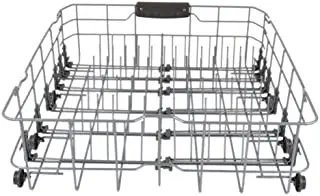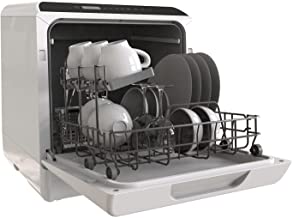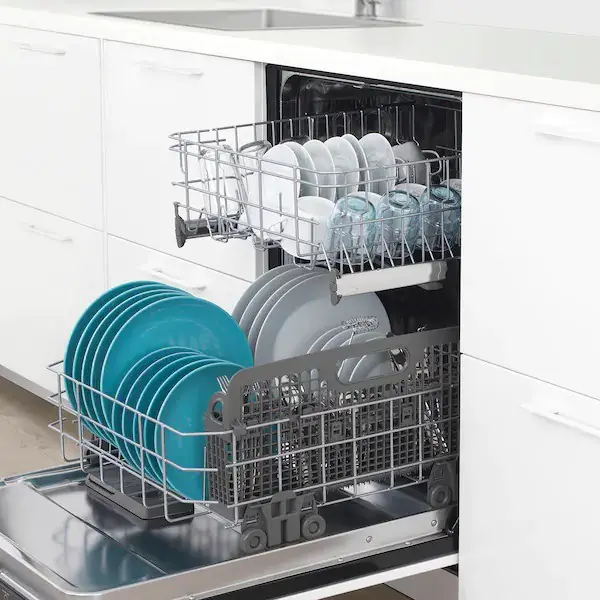The dishwashing machine is one of the most celebrated inventions of the 21st Century. This appliance has made work easier, increasing its popularity in society.
If Kitchenhandsdown was to rank the importance of a dishwasher in the kitchen today, we would say that it definitely ranks among the Top 20 Most Important Kitchen Appliances.
You can comfortably use your dishes without having to worry about the washing process. As a cleaning equipment, the dishwasher requires occasional cleaning as well.
This article breaks down the cleaning process of the dishwasher to guide you through. It is necessary to clean the dishwasher as it restores the appliance efficiency in the event of under performance.
What you need:
- Baking soda
- White vinegar
- Bleach
- Dish soap
- Commercial cleaners
- Sponge
- Lemon juice
Procedure for Cleaning Dishwashers
Once you know the right steps to follow in cleaning your dishwasher, you will find it easy if not fun to clean your dishwasher.
Follow the recommended easy steps on cleaning your dishwasher for excellent cleaning results.
Cleaning the exterior
Create a solution of warm soapy water for the routine rinsing of the dishwasher. For tough stains, use stronger dish soap to make the solution.
For the grime and fingerprints on the dishwasher’s outer part, wipe off with a paper towel, sponge, or soft cloth with the soapy water.
Wet the cloth/ sponge and wring out any excess water to avoid making a mess on the floor.
After that, scrub the door frame, taking a keen interest in the handle and corners, which usually has a lot of dirt build up.
Do not pour or splash water directly on the door due to electrical components that may get damaged when in contact with excess water.
For the base, walls, and interior side of the dishwasher’s door, clean with a paper towel to remove any gunk. For tough stains, wash with baking soda and vinegar.
For areas that are hard to reach, such as the corners and hinges, use a kitchen brush or an old toothbrush to remove the grim. Dip the brush in soapy water and scrub off the dirt.
Cleaning some of the interior elements
Dishwasher Racks

On the racks, it is common to note some solid coat on the surfaces due to regular use. Take out the racks from the dishwasher by sliding out the door and lifting them from their tracks.
Also, take out the utensil’s holder. Wipe off any food particles on the surfaces with the help of a paper towel. Finalize the cleaning process by cleaning with warm soapy water.
Ignoring the racks during the cleaning process will waste your effort as the dishwasher won’t be clean regardless of how well you clean the inside. Moreover, a clean rack keeps your drain clean.
Drain
It is now time to wipe the drain. Figure out the drain’s position and, using a paper towel, wipe off all the accumulated debris, particularly solid and grease.
The buildup of such grime causes blockage of the drains and damage to the pipes and dishwasher, hence reducing efficiency.
Rinse off with clean water in a normal rinsing cycle. Dampen a paper towel or a clean cloth and remove the entire soapy residue in areas where water may not reach during the rinsing cycle.
Washing the components of the rinsing cycle
Filter system
The filter system varies with every dishwasher. Remove the filter system located at the base of your dishwasher. Beneath the rotating spray arm, there is a large gray disk with a tiny cylinder.
Rotate the cylinder in an anticlockwise direction to remove it as well as the parts beneath it. The filter breaks down large food particles to prevent them from getting stuck in the drain.
Clean the filters at least every month as these food particles can clog the filters causing bad odor.
Scrub every part individually with a brush and warm soapy water to get rid of the solid stains.
After that, wipe with a paper towel or sponge to check for any left gunk. At this point, a kitchen brush or a toothbrush will remove the remaining debris.
A faucet or a hose with a strong spray setting is useful in accessing hard-to-reach areas.
Spray arm
Get the spray arm out of the dishwasher and wash it with warm water in the sink. Get rid of any food particles that can clog the sprayer’s hole.
To clear any debris on the holes, use a toothpick or a hanging wire.
A clogged hole can limit the amount of water available to clean your dishes resulting in non-clean dishes after a washing cycle.
Getting rid of tough stains and smells
Vinegar

Return the dish racks after cleaning and add some vinegar in a bowl or cup on the top rack. Vinegar is effective in removing tough stains and smells.
You can also use a stronger commercial cleaner than vinegar to get rid of discoloration stains caused by the minerals in the water.
With the hottest water setting, run the normal rinse cycle with the dishwasher’s door closed. The hot water dilutes and disperses the vinegar, giving your dishwasher a sparkling look.
Drain the water when the cycle is complete. Repeat the process with more vinegar until the dishwasher is totally clean.
Baking soda
To remove any odors and tough stains left after the vinegar wash, sprinkle some baking soda on the dishwasher base.
Set the dishwasher for a short cycle with hot water. Do not let it run for a long cycle since it is abrasive and can damage the dishwasher’s interior.
Moreover, baking soda also clears up any left-over food particles.
If the stains and odor persist, do not use more baking soda; instead, use more vinegar, lemon juice, or a commercial cleaner.
Bleach
To get rid of mold stains:
- Use bleach, which is more effective than vinegar and baking soda.
- Never mix bleach and vinegar as it reacts to produce the toxic chlorine gas.
- Run the dishwasher in a medium length cycle with the use of hot water.
The water dilutes the bleach to avoid it, damaging the interior. Rinse it out thoroughly.
Drying a dishwasher
Drying the dishwasher is harder than the cleaning process.
You can, however, try the following methods to dry your dishwasher;
Heated Air:
A number of dishwashers, particularly the old models, have a heating element at the bottom, which heats the air inside, thus aiding in the drying process.
Fan:
Some dishwashers come with a fan that is efficient in air circulation, allowing for quick drying of the dishwasher.
Air Dry:

Open the dishwasher’s door for a few minutes and allow the escape of hot air and humidity to facilitate the drying process.
Methods of boosting the dishwasher’s drying
You’ll find steps you can take for improving drying performance even if the dishwasher does not feature fancy drying choices. Some of the recommendations include:
- Opening the dishwasher door
As soon as the cycle ends, you should open the doors a couple of inches. This allows for the escape of trapped moist air.
- Leave enough space between dishes
Don’t allow dishes to touch each other during washing, and you should not overload your dishwasher.
The idea is to improve air and water flow, which helps in improving improve drying.
- Using a rinse aid
It will help in preventing spotting and improve drying. The rinse aid will help break the bond between your dishes and water molecules. This causes water to sheet off of the dishes.
- Using the heat feature
Drying occurs well when there’s more heat. Depending on the type of the dishwasher, you might have the choice of adding heat during the wash, rinse, or dry cycle.
- Emptying the bottom rack first
Water accumulates on concave surfaces, like glasses and mugs that belong upturned on the top rack. Emptying the lower rack first will help prevent water spillage onto the bottom rack’s contents.






